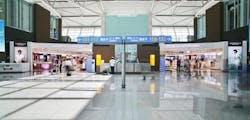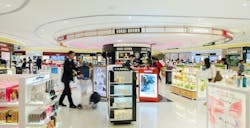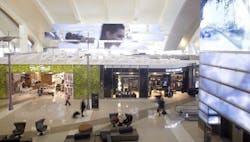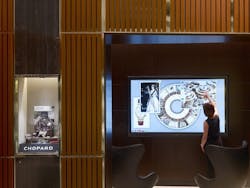Five trends for airport retail
Once relegated to tired sundries and souvenir shops, airport retail is literally cleared for takeoff. With a projected growth of over 70% in the next four years, it’s one of the fastest growing segments in retail.
But it won’t happen by magic; airport retailers will need to seize the day. The day for trendy, unique retail that goes beyond travel-sized toothpaste and a pre-flight Toblerone and taps into the hunger for something new. Something different. Something that compels 10,000 likes on Instagram. And in order to get there, we predict five major trends that will take hold over the next few years.
1. Hot Property
Singapore’s Changi International Airport saw $1.6 billion in sales in 2016. By 2025, travelers from China are expected to spend a whopping $450 billion in international travel. And when compared to a typical retail high street or shopping mall, sales per square foot at airports are astronomical. Bottom lines like this are leading more and more airports around the world to focus their attention on this newfound source of revenue. But with more retailers and brands ready to jump into this rapidly ascending market, and multiple private and public stakeholders complicating the process, operators and airports must carefully consider a number of factors as they look to expand.
The main draw of airport retail used to be “duty free” prices and a place to buy travel toiletries and snacks from a drab, fluorescent-lit display. As customers come to expect just as much from an airport shopping experience as they expect from a cutting-edge urban shopping center, only retailers that focus on compelling merchandising and offering something different will capture their attention.
Current airline regulations mean most travelers have a significant amount of time to kill once they pass through security. Many are in the mood to buy something new, especially perfume, cosmetics and beauty products, but better dining options, updated airline lounges and amenities are all competing for their time and budgets. The most sophisticated strategies to catch their eye incorporate interactive storefronts, personal services and amenities, and products that can’t be purchased elsewhere. Shilla’s two-story beauty loft at Changi is a real draw for the wandering cosmetic connoisseuse, combining more than 500 mid-market and luxury brands, like Chanel, Dior, La Prairie and SK-II. Even locals stop in to pick up their favorite beauty products before heading home.
Brands that tap into the need for speed are behind other innovations; rapid spa treatments, click-and-collect connected to in-flight e-tail, and location-specific sales and offers pushed to smart phones are just some of what’s going to start popping up at major airports. Under the category of wellness, we’re seeing branded meditation gardens, yoga studios and sleep pods, all making travelers reluctant to board their flights and leave the airport, minimized legroom notwithstanding.
2. The Wild Blue Yonder of Tech
They tell us that social media is going to become an even bigger part of every aspect of our lives, but the truth is, it’s only catching on at a handful of airports. When it works, it can help form a place-making, must-be-seen landmark. Things like the nine-meter digital tree in Singapore’s Changi airport fall into that category, making for an Insta-worthy travel experience with its 64 360-degree digital screens. Other airports may start incorporating similar social media connections, but the real tech story in the airport is about unseen digital infrastructure. And the first airport to get it right will truly disrupt travel retail for the better.
This part of the conversation is less sexy than perfume displays and luxury handbags, but the back-of-house component is crucial to the future of retail. It’s only a matter of time before Amazon’s “shopping like stealing” concept makes its way to stores everywhere, but airports will most likely lag behind; the added layer of security and an entrenched warehouse/merchandise mindset not only lead to chaotic visual merchandising and slow-to-adapt stock, they make it more difficult to implement the latest technology. Once airports jump these hurdles, the future is real-time, fully connected, Big Data systems that will revolutionize the customer path to purchase and the way we think about shopping at the airport.
With this kind of technology in place, our design team imagines minimal merchandise on the floor with the ability to scan the price tag and a boarding pass, then picking it up at the point of sale, or even direct robot delivery.
The connected system would allow airport retailers to rethink how they process and warehouse merchandise, so popular products are always on hand during peak times and storage space can be reduced for other products. It also has the potential for a social component, allowing displays to show in real time what the highest rated or most purchased items are, adding to the feeling that this isn’t the same shopping experience you could get at any other department store.
The first airport retailer to get the seamless tech equation right will be a substantial cut above the rest, but even airports that aren’t close to the cutting edge of technology are trying to do something to make themselves stand out. The connection to customer behavior and making the travel experience genuinely better will be the true test of how much impact it has.
3. The Family Connection
Most brands, especially luxury brands, want to ultimately appeal to affluent, fashionable people in their late 20s and early 30s, but airports and airport retail would do well to expand their circle beyond this 20-something jetsetter archetype and focus on a demographic that they’ve often ignored: families.
Millennials have always valued seeing the world and are willing to spend money on travel, and that hasn’t changed just because they have toddlers in tow, but they’re also finding a big difference between flying solo and traveling with kids. Parents are willing to pay to access kid-friendly food and play areas and will likely choose a particular airport route if it means travel time isn’t filled with whining and tantrums. Entertainment and edutainment that appeal to the entire family will encourage this demographic to spend more time and more money, but only if it’s accessible and available.
The landside of the airport is getting in on the game too. German company Emmasbox has a pilot program testing out click-and-collect from the baggage claim, where travelers can use this “dead time” to order grocery items or meal kits and pick them up from an on-site fridge. The concept dovetails nicely with the rise of AirBnB, since many travelers, especially families, will either be heading home or to a rented apartment or house without access to the dining amenities of a hotel.
4. A 35,000-Foot View of the Airport
Between hotels, retail, dining and millions of people that pass through them every year, airports really are like miniature cities. And just like other cities, the high-value land immediately surrounding them is ripe for development. A true “aerotropolis” holds the potential for world-class urban planning, major infrastructure and creating both airside and landside landmarks. The catch is that the number and diversity of stakeholders can make it even more challenging, especially in the United States and Europe. Many airports in Asia have already achieved some level of aerotropolis status because they have excellent infrastructure, good mass transit and it’s actually convenient to get there. There’s a reason why all the top ranking airports are in Asia; the facilities and digital experience are better, for sure, but it’s the service and efficiency that set them apart. Los Angeles, London and Paris are trying to enhance their terminal environments with better retail and a more pleasant overall experience, but they still have a long way to go to catch up to the likes of Hong Kong and Changi airports. We’re already seeing plans for vast mixed-use developments in cities like Memphis and Amsterdam and we predict that this is a long-term trend that’s here to stay.
5. Local Matters
At the end of the day, great retail, whether it’s on Michigan Avenue, Rodeo Drive or at an airport, will always be about the customer experience. 62% of US consumers state that the most important part of travelling is to explore the authentic culture of the destination, rising to 78% for Chinese respondents (source: Expedia/Future Foundation, 2016). Just as Americans have spent the last decade moving away from suburban shopping centers with the same stale lineup of chain stores in favor of local, unique shopping experiences, travelers are looking for a similar level of local flavor in airport retail.
As the first or last impression most people get of a city, major airports are taking note. The recently renovated Tom Bradley terminal at Los Angeles International Airport now offers a mall-like retail environment. After the security gates, travelers take the escalator into the various retail experiences offered in the grand hall area. The already-famous digital media screens are filled with images of California’s beaches and abstract art. The range of the retail offer in the new Tom Bradley is also well beyond the ordinary with series of luxury brand names, making it feel more like an upscale shopping center than an airport terminal.
CRTKL’s latest project win for the liquor and tobacco store with CDFG at Hong Kong International Airport will offer major customer interaction with merchandise and a new way of organizing the space using different “rooms” that curate different liquor types. Getting customers to the point-of-sale is part of any retail journey, but this level of engagement really gives shoppers the opportunity to be educated about what they’re buying.
In the next few years, we also predict a rise in pop-up stores and experiences in airports that will offer changing inventory and brands on a temporary basis, to give frequent fliers a change of pace and first-timers will feel like they’re visiting a true shopping destination, not just an airport. It would also give smaller, local brands exposure to new markets, allowing airport retail to be a true part of the community.
Kevin Horn leads the retail interiors sector of the Los Angeles environments studio and specializes in the design of entertainment, retail, mixed-use and hospitality projects. Throughout his 20-year career, Kevin’s expertise in the conceptualization, presentation and design of interior environments, environmental graphics and identity systems has led to many award-winning projects around the world.





